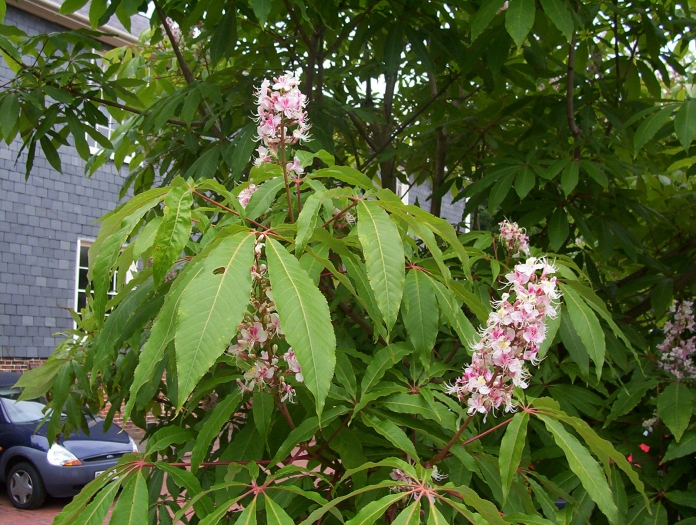Indian Horse Chestnut
(Aesculus indica)
Indian Horse Chestnut (Aesculus indica)
/
/

peganum
CC BY-SA 2.0
Image By:
peganum
Recorded By:
Copyright:
CC BY-SA 2.0
Copyright Notice:
Photo by: peganum | License Type: CC BY-SA 2.0 | License URL: https://creativecommons.org/licenses/by-sa/2.0/ | Uploader: peganum | Publisher: Flickr |






















Estimated Native Range
Summary
Aesculus indica, commonly known as the Indian Horse Chestnut, is a deciduous tree native to temperate mixed forests and montane river valleys of the Himalayas. It typically grows to a height of 9–12 m (30–40 ft) with a similar spread of 11–15 m (35–50 ft), forming a rounded canopy that is visually striking in landscape settings. The Indian Horse Chestnut is notable for its large, palmate leaves that can be 10–20 cm (3.9–7.9 in) long and 2–6 cm (0.79–2.36 in) wide, which turn yellow or brown in the fall, adding seasonal interest. From June to July, it produces an abundance of showy white flowers arranged in erect panicles, which are highly attractive to bees and other pollinators. The flowers give way to spiny capsules containing large, glossy seeds that ripen in October.
The Indian Horse Chestnut is valued for its ornamental qualities, including its impressive floral display and its bold foliage. It is used in urban and suburban landscapes, often as a specimen tree or in large gardens where its full canopy can be appreciated. This species is hardy to −18 °C (0°F), suitable for USDA zones 7–9. It thrives in full sun to part shade and prefers well-drained soils, although it is adaptable to various soil conditions with slow to fast drainage rates. While it is generally easy to maintain, it can be susceptible to leaf blotch and horse chestnut scale. Additionally, the tree’s large size and dense canopy may require space to grow without interfering with structures or other plantings.CC BY-SA 4.0
The Indian Horse Chestnut is valued for its ornamental qualities, including its impressive floral display and its bold foliage. It is used in urban and suburban landscapes, often as a specimen tree or in large gardens where its full canopy can be appreciated. This species is hardy to −18 °C (0°F), suitable for USDA zones 7–9. It thrives in full sun to part shade and prefers well-drained soils, although it is adaptable to various soil conditions with slow to fast drainage rates. While it is generally easy to maintain, it can be susceptible to leaf blotch and horse chestnut scale. Additionally, the tree’s large size and dense canopy may require space to grow without interfering with structures or other plantings.CC BY-SA 4.0
Plant Description
- Plant Type: Tree
- Height: 40-60 feet
- Width: 30-50 feet
- Growth Rate: Moderate
- Flower Color: Yellow, Pink, White
- Flowering Season: Summer
- Leaf Retention: Deciduous
Growth Requirements
- Sun: Full Sun, Part Shade
- Water: Medium
- Drainage: Slow, Medium, Fast
Common Uses
Bee Garden, Bird Garden, Butterfly Garden, Deer Resistant, Edible*Disclaimer: Easyscape's listed plant edibility is for informational use. Always verify the safety and proper identification of any plant before consumption., Hummingbird Garden, Rabbit Resistant
Natural Habitat
Temperate mixed forests and montane river valleys of the Himalayas
Other Names
Common Names: Indian Horse-Chestnut, Himalayan Horse Chestnut
Scientific Names: , Aesculus indica, Pavia indica, Pawia indica,
GBIF Accepted Name: Aesculus indica (Colebr. ex Cambess.) Hook.